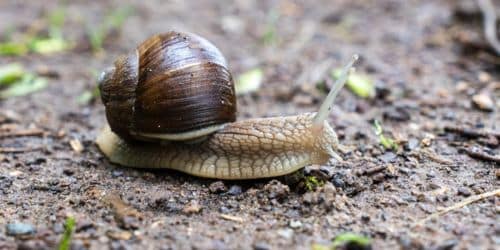According to various research studies, one in every fifty Nigerians is a snail farmer. This goes a long way to say that snail farming is a profitable business. If you’re considering starting a snail farming business in Nigeria, you need to consider some factors, which I’ll explain in this article. Read on.
What Is Snail Farming?
Heliculture is the term used to describe snail farming. Snail farming is the method of rearing snails for human consumption.
To produce fertile eggs, each snail possesses female and male reproductive organs. As a result, it is safe to assume that snails are Hermaphrodites.
In terms of nutrition, snails are an excellent source of calcium, phosphorus, iron, and protein. Snails are also low in cholesterol, salt, and fat.
Snail farming is a profitable and sustainable agribusiness in Nigeria. You only need a minimal investment for a small start-up to profit from your snail farm. However, in order to maximize your profits, you must be willing to increase your investment on a larger scale.
Understanding Snail Breeds
Snails vary in species, color, size, and shape. The African land giant snail (Achatina achatina), which is the most popular because to its economic size, is the most common in Nigeria, followed by the Burgundy snail (Helix pomatia), the garden snail (Cornu aspersum), the white garden snail (Theba pisana), and the milk snail (Otala lacteal).
Feeding
Make food and water available to your snails every morning and night. Plantains, pumpkins, potatoes, lettuce, pawpaws, cabbage, bananas, cucumbers, and other vegetables can be fed to snails.
Snails usually eat supper leftovers and unseasoned green leaves. Calcium is also required for the development of their shells. So make sure to include limestone and eggshells in their diets.
Corn, pap, beans, and rice, all without salt, are also excellent staples for snail feeding. Calcium is essential in snail feeding since it increases snail growth and results in thicker shells.
Housing
Snails require comfort in order to thrive. The size of the snails’ home will affect their level of comfort. The shape and size of the snail house are also determined by the size of your snail farm.
If you intend to get into commercial farming, secure a permanent location for your snail farm. People nurture snails in boxes constructed of wood and wire gauze, depending on the stage of development and behaviors of the snails.
Sort your snails by age once you’ve found what works for them. Separate them into adult, juvenile, and freshly hatched nails, and make sure the younger nails have a safe haven away from predators. To prevent dehydration, keep the temperature surrounding the snails adjusted with fabric and leaves.
Type Of Soil
The snails’ principal habitat is the soil, which is vital for their existence due to the chemical components found in it. Because of the large level of organic matter in sandy-loamy soil, you should choose it. Because of its balance, this sort of soil is also appropriate for snails to deposit their eggs and consume water.
Diseases And Pests
Turkeys, geese, chickens, ants, snakes, lizards, and termites are common snail predators. Snails are not associated with many diseases, but bacteria and fungi are commonly found in overcrowded cages.
fungus, nematodes, and fungus can spread by contact with toads, frogs, birds, weasels, skunks, moles, mice, and rats. Keep an eye out for pest activity and remove your snails from the pens as needed.
Reproduction
When snails reach sexual maturity, which occurs between 8 and 12 months after hatching, they lay eggs that hatch between 4 and 6 weeks later.
There is no set mating season for snails, but you can expect 5 to 6 clutches of eggs per year. Only if you place them in suitable conditions will you find an average of 200 eggs in each clutch.
After hatching, the young snails can survive in the soil for 5 days. When they hatch, remove them from the mature snails in a pen with enough room and shelter.
This stage may be time-consuming, but the market value and reproductive nature of the snails will make up for it.
Harvesting
It takes an average of two years for a snail to attain full maturity. Inspect the brim of the shell to determine whether or not the snail is mature. Mature snails have a robust and thick shell. Make certain that you only harvest mature snails.
Keep some snails for future reproduction while harvesting them for market sale. The snails you save for breeding will serve as the foundation stock. Baskets, boxes, bowls, and containers can be used to collect snails.
How to Start Snail Farming in Nigeria
#1. Determine which snail species to farm.
You must utilize only one species of snail while constructing a snail farm. According to research, snail species such as Achatina achatina are better suited to warm climatic places such as Africa.
#2. Prepare your farmland for development.
Your snail habitat should allow your snails to graze freely. Overcrowding your snailery impedes snail development and should be avoided. Overcrowding increases the likelihood of disease outbreaks; therefore, snail housing should be well-spaced.
Because snails are adept at eluding capture, you should make every effort to build escape-proof housing. With a soil depth of 10 inches and trees surrounding it, you can utilize a pen house that is spacious and accessible.
#3. Get your snails.
You’ll need snails if you want to build a snail farm. It’s time to get some fresh, quality snails from the market or any farm after you’ve put up adequate homes and farmland for the snails. It is always preferable to be able to inspect the snails before purchasing them to ensure that they are healthy.
You’ll want to start your snail farm with healthy, fully-grown snails that will lay eggs and help populate your farm. Examine the snail’s shell. If they have a lip, they are a fully mature snail.
#4. Snail feeding and raising
Snails are vegetarians and can be fed cabbage, cucumber, mango, banana, eggplant, pear, tomato, paw-paw, cassava, okra leaves, or lettuce. You can, however, feed snails pineapple, banana, or paw paw.
Mating and egg-laying are essential components of snail farming. Mating season is often in the spring and summer. Snails, as hermaphrodites, can fertilize each other once they reach a certain age. To ensure that egg laying goes easily, use high-quality soil with the appropriate temperature and humidity.
#5. Snail harvesting and selling
It is not economical to harvest your snails before they reach maturity; they must be mature before being harvested. Do not harvest all of the matured snails at once for market. It is critical to preserve a few for breeding and as basic stock for your snail farm.
Snail is in high demand and has a high market price. The snails are easily sold in the local market. The global consumption of snail meat is rapidly increasing. As a result, exporting to the worldwide market can increase your earnings.
The Cost of Starting a Snail Farming Business In Nigeria
If you’re wondering how to start a snail farm, you’ll need to budget for housing, buying fresh snails, feeding, handling and processing the snails, marketing, and transportation.
You can begin the business with N60,000 or N100,000, depending on the size of your snail farm. Aside from your investment, you can now produce 1,000,000 snails valued more than N5 million twice a year.
This is made possible by the availability of extraordinarily prolific Achatina achatina snails, which lay 200-400 eggs in a single batch two or three times a year. If you make 100,000 snails that sell for N250 each (N250 x 100,000), you will earn N2,500,000. If you generate 1,000,000 snails, you will earn N25,000,000 per year or more.
Creating a snail farming business plan is an important step for novices to do before getting started. This will provide you with a thorough overview of all that has to be done.
Problems Of Snail Farming In Nigeria
#1. Predators
Fear of predators appears to be at the top of the list of issues encountered in snail farming. Snails are delicate creatures, and their slowness makes them vulnerable to predators. People commonly believe that snakes, soldier ants, and rats are the sole snail predators, but this is not true.
The Green Snail, a terrestrial snail-like animal, preys on land snails. The green snail can eat hatchlings of Achatina achatina. Insects, millipedes, crabs, crickets, turtles, frogs, toads, birds, and other predators are also present.
Solution: safeguard your snails by killing these predators whenever they are spotted, and avoid raising animals such as birds, cows, and so on on the same farmland as the snails. Additionally, the snail house should be elevated (to make entry harder for creeping predators); trenches should be excavated around your snail farm (which should also contain used oil to keep ants at bay).
Predator control structures should be erected to keep rats and other creeping animals at bay, and snails should be checked on a regular basis because they cannot shout for aid when in danger.
#2. Type of soil
As delicate and insignificant as it may seem, the type of soil in which your snails live has a significant impact on their capability, health, and reproduction. Soil pollution can cause a jump in snail mortality on the farm, thus it must be monitored at all times.
Solution: Your snail farm’s soil should be finely ground and preferably loamy, with a low water-holding capacity. The snail farmland should not be acidic but rather calcium-rich, as calcium strengthens a snail’s shell. As a result, perform a pH test on your soil, sterilize it to eliminate predators, and, most importantly, change your soil every three months (for intensive housing systems).
#3. Snail feed
Snails, like all living things, must eat in order to grow. The right feed for your snails is as important as the air they breathe. Giving snails the incorrect feed will most likely stunt their growth or increase their mortality rate. You should be aware that breeding snails on a large scale necessitates a significant feeding commitment, and as such, you should plan ahead of time what your snails will eat.
Remember that snails do not grow slowly (as we once thought), but the quality of the food you feed them influences their growth rates.
#4. Light Intensity
Snails, unlike plants, do not require a high intensity of light to manufacture their food. In fact, snails prefer to hide away from light; therefore, you must ensure that the light intensity of your farm is kept to a bare minimum at all times for your snails to experience a consistent growth pattern; mating events, and egg-laying activities.
Solution: Snails are more active at night than during the day, so the pen should always be cool at night with less light available.
#5. Human activities
Some changes that humans make to their environment have an impact on the health of snails. As previously stated, snails thrive in a humid tropical forest zone; however, activities such as bush burning and deforestation can be detrimental to snail farming.
Bush burning and deforestation make the snails’ habitat difficult to live in because they expose them to harsh weather and their eggs to direct sunlight. When this happens, they will become extinct because they will be unable to successfully breed and their mature offspring will perish.
In a nutshell, keep an eye out for poachers trespassing on your farm or any man-made activities (such as bush burning, chemical spray, tree cutting, and so on) around your farm that may affect the productivity of your snails.
Solution: To avoid this, the environment surrounding the snail farm should be kept as tropical and natural as possible. Though the snails are being reared, the pen should feel like a home to them, resembling the coziness of a tree root, while also being secure enough to deter uninvited human visitors.
#6. Parasites and diseases
This is a major problem in Nigerian snail farming that affects all types of farming; it cannot be completely eradicated, but it can be reduced to a manageable level. Diseases and parasites cannot be seen with the naked eye, but they are detectable once they begin.
A fragile shell is one of the symptoms of an infected snail. Inactivity in the snail, excessive serum secretion (oedema), fewer or no tentacles, inability to reproduce, impaired opercula, loss of color in the new shell, and so on. Some of these diseases and parasites are as follows:
Fusarium spp. causes fungal diseases that primarily affect snail eggs, causing them to die before hatching.
Bacterial infections produced by Pseudomonas spp produces intestinal dysfunctions in the snails and disrupts their normal growing process.
Deficiency disease arises due to improper feeding or absence of critical nutrients and minerals that is needed for optimal growth and development. Deficiency disease leads to cannibalism in snails when older snails eat on the smaller ones to supply nutrients that are missing in them.
Solution: A snail farmer must, therefore, be cautious and observant. Feed your snails with the proper diet and critical nutrients in the right quantity. Feed your snails to boost their immune system. Ensure to differentiate infected snails from healthy ones and embrace best farm hygiene.
#7. Climatic factors
The climate condition of the snail farm determines the survival and reproduction rate of the snails. Snails only exist in high humidity environment, persistently low temperature and a season that is not dry. This is not naturally achievable because of the seasonal climate changes that occur in the weather condition. The good news is that if it is not naturally possible, it can be artificially done.
Solution: The optimum temperature for the snail farm is from 23 to 28 degree Celsius; any higher temperature would influence appropriate development, normal feeding, reproduction and everyday activities of your snails. The humidity of air in the snail farm shouldnt be lesser than 70-90% and this is reached during the rainy season. During the dry season, snails die from heated air; consequently, the pen holding the snails should be regularly doused with water.
How Many Months Does It Take Snail To Mature?
It takes an average of two years for a snail to attain full maturity. Inspect the brim of the shell to determine whether or not the snail is mature. Mature snails have a robust and thick shell. Make certain that you only harvest mature snails.
How Much Is One Snail Sold In Nigeria?
The yearly demand for snails in Nigeria has been assessed to be at approximately 7.5 million kg per year and the price of a medium-sized snail is about ₦250 – ₦600 depending on the size.
Conclusion
In terms of cost and time, snail farming is a low-risk industry. Unlike many other livestock companies, snail farming involves extremely little starting and operating costs. You can also build up your snail farm at the backyard of your house to save cash on the acquisition of farmland.
The optimum time to start up a snail farming is the rainy season especially from July to October because that is the time snails generally start to breed. You should also notice that costs of snails multiply during shortage from March and December, which is the dry season.
- Fish Farming Business Plan in Nigeria: Step-by-Step Guide
- What is Commercial Farming? All You Need To Know 2023
- Saffron Farming: Step-by-Step Guide On How Saffron Can Be Grown
- Avocado Farming In Nigeria: All You Need to Know






